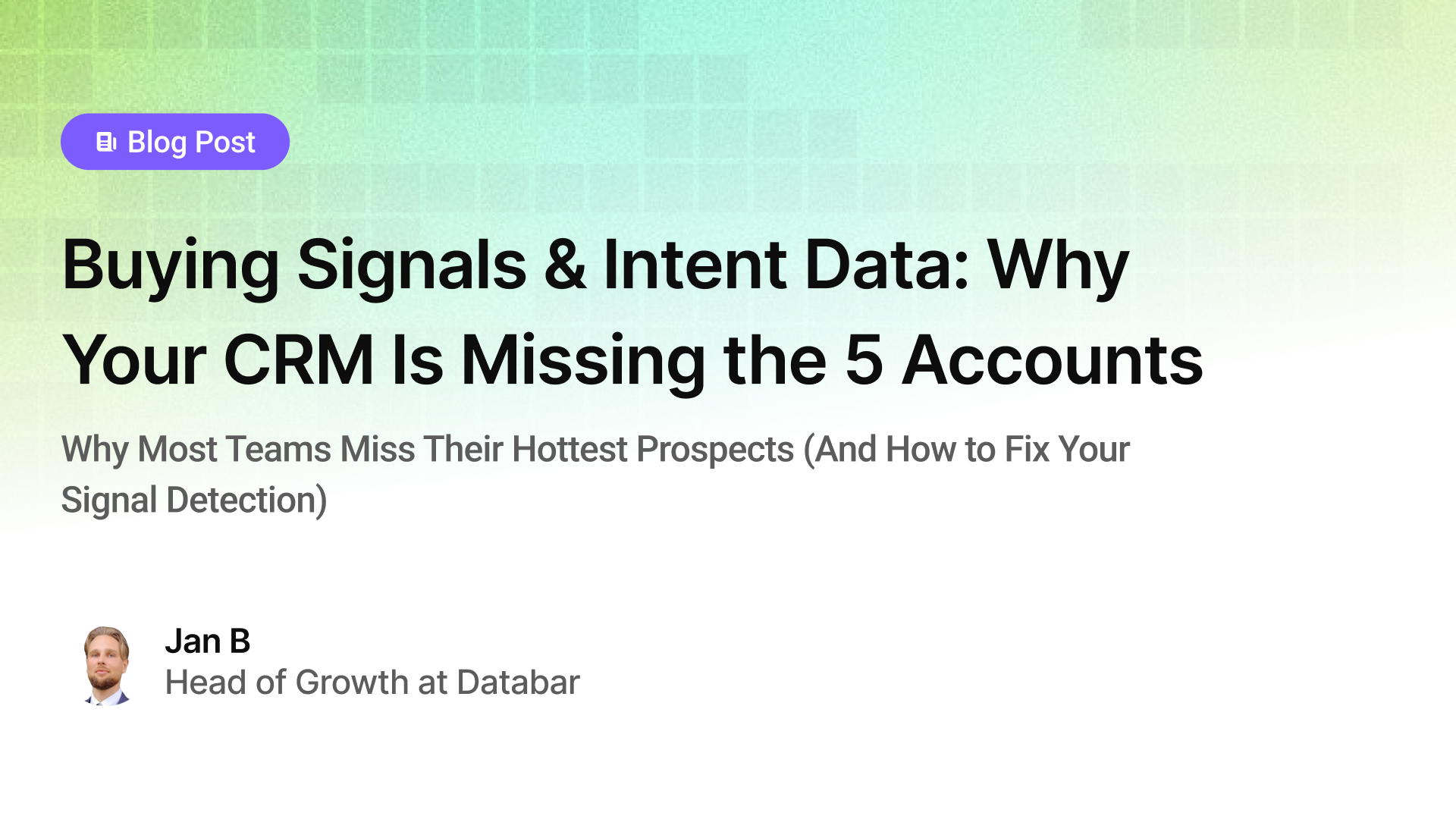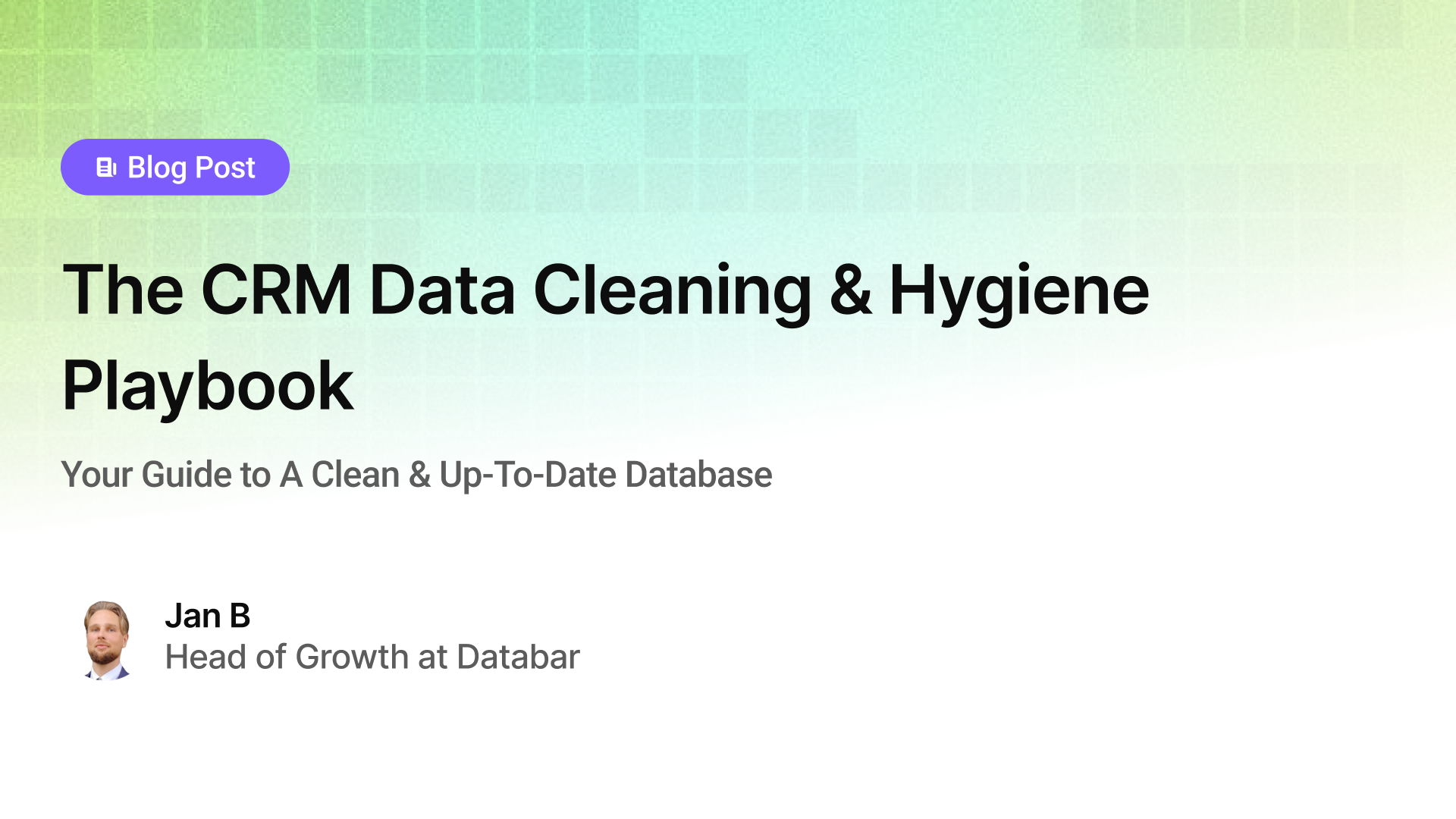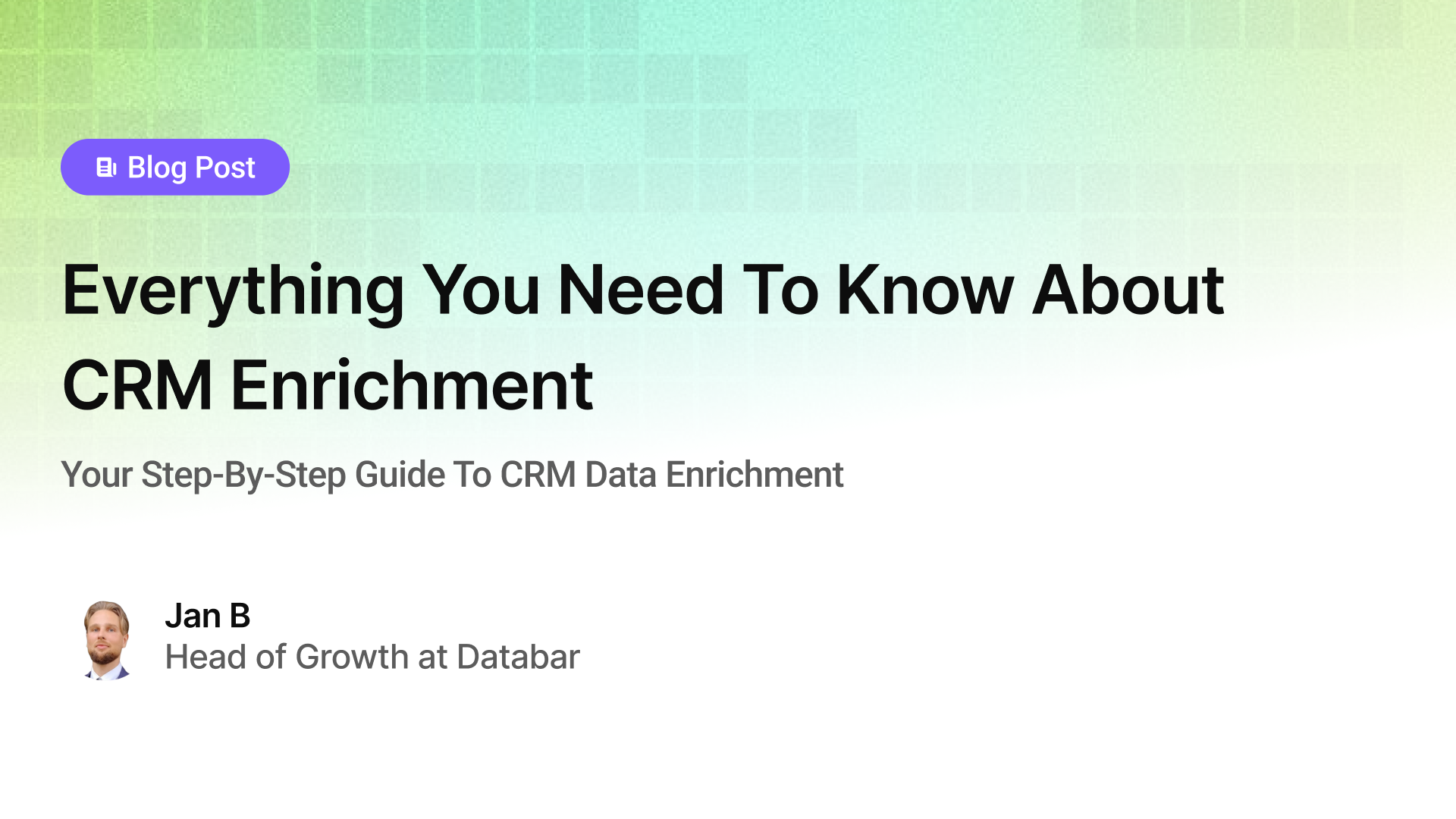Vibe Marketing: The Future of AI-Powered Marketing Systems
What is vibe marketing and how to get the most out of it?
Blogby JanMay 12, 2025

Marketing is experiencing its most significant transformation since the rise of social media. While most marketers are still caught in endless meetings and slack threads, struggling to launch campaigns after weeks of planning, a new paradigm has emerged: Vibe Marketing.
This revolutionary approach combines AI tools with automation platforms to create marketing systems that work for you 24/7, testing hundreds of variations simultaneously and optimizing campaigns with minimal human intervention. The result? What once required entire marketing departments can now be accomplished by one smart marketer paired with the right AI workflows.
In this comprehensive guide, we'll explore exactly what Vibe Marketing is, why it represents an unprecedented opportunity in 2025, and how you can build your first Vibe Marketing system using tools like Databar to integrate multiple data sources and orchestrate powerful marketing workflows.
What Is Vibe Marketing?
Vibe Marketing applies the same principles as "vibe coding" (seen in tools like Replit and Bolt) but to marketing operations. It's a systems-based approach that leverages AI and automation to build complete marketing machines that can test, optimize, and scale with minimal human intervention.
At its core, Vibe Marketing is about:
- Building interconnected AI systems rather than using isolated tools
- Testing dozens of variations simultaneously instead of committing to single approaches
- Making data-driven decisions rather than relying solely on intuition
- Creating automated workflows that handle repetitive tasks
- Focusing human effort on strategic judgment and creative direction
As one prominent Vibe Marketing practitioner describes it: "marketing in 2025 resembles stock trading – you can test things instantly, immediately see what's working, and make rapid, data-informed decisions based on real-time results."
The shift from traditional marketing to Vibe Marketing is huge. Traditional approaches feature large specialized teams, siloed departments, endless meetings, weeks-long launch timelines, and prohibitive costs. In contrast, Vibe Marketing requires just one smart marketer with good judgment paired with AI agents and automated workflows, enabling hundreds of simultaneous tests and launches in days rather than weeks.
Why Vibe Marketing Is Creating Unprecedented Opportunity
Three powerful forces have converged to create a unique window of opportunity for Vibe Marketing:
1. AI Has Reached Marketing Maturity
AI tools have surpassed the threshold of effectiveness for most marketing tasks. Models like Claude excel at writing compelling marketing copy, while tools like Perplexity deliver sophisticated research capabilities. Visual AI can generate product imagery and video concepts at increasingly professional quality.
These capabilities mean marketers can now delegate much of the creative and production process to AI systems while focusing on strategic direction and final approval.
2. Automation Tools Have Become Accessible
Platforms like Make.com, Zapier, and N8N have democratized workflow automation, allowing non-technical marketers to build sophisticated systems without coding knowledge. These tools connect your various platforms, enabling seamless data flow between them.
Even more importantly, Databar has emerged as a key player in the Vibe Marketing ecosystem by allowing marketers to integrate data from over 100 providers via API and push to outbound tools of choice – creating powerful data-driven marketing workflows without requiring developer resources.
3. The Cost of Building Marketing Systems Has Plummeted
What once required expensive development teams and months of work can now be built for a fraction of the cost. The combination of affordable AI APIs, user-friendly automation platforms, and tools like Databar means sophisticated marketing systems are now within reach for businesses of all sizes.
This democratization has created an environment where small teams with the right knowledge can compete effectively with much larger organizations – but this window won't remain open forever as more marketers adopt these approaches.
|
Traditional Marketing |
Vibe Marketing |
Impact on Results |
|
Weeks to launch campaigns |
Days to launch |
5-10x faster time-to-market |
|
1-2 variations tested |
Dozens tested simultaneously |
3-7x more effective messaging |
|
Siloed teams and tools |
Integrated AI workflows |
40-70% reduction in human effort |
|
Intuition-based decisions |
Data-driven optimization |
30-50% improved conversion rates |
|
High-cost specialist teams |
One smart marketer + AI systems |
60-80% cost reduction |
Core Components of Effective Vibe Marketing Systems
Building effective Vibe Marketing systems requires understanding the key components and how they work together:
AI Models for Marketing Functions
Different AI models excel at specific marketing tasks:
Claude consistently outperforms other models for marketing copywriting, making it the preferred choice for creating compelling headlines, ad copy, email content, and social media posts. Its ability to maintain brand voice while generating variations makes it ideal for testing different messaging approaches.
Perplexity specializes in research capabilities, making it valuable for gathering market intelligence, competitor analysis, and audience insights. Its ability to extract and synthesize information from across the web powers data-driven marketing decisions.
Midjourney and similar visual AI tools have reached sufficient quality for concept development and asset creation, allowing marketers to rapidly generate visual content for testing without extensive design resources.
These models serve as the "workers" in your Vibe Marketing system, handling the creative and analytical heavy lifting.
Workflow Automation Platforms
The "connective tissue" of Vibe Marketing systems comes from workflow automation platforms:
Make.com (formerly Integromat) provides visual workflow building with extensive integration options. Its scenario-based approach allows marketers to create complex automation flows connecting various tools and platforms.
N8N offers an open-source alternative with powerful capabilities for building marketing workflows, including conditional logic and data transformation features particularly valuable for marketing automation.
Zapier provides user-friendly automation with a vast library of app connections, making it accessible for marketers beginning their Vibe Marketing journey.
These platforms orchestrate your marketing systems, ensuring that data flows smoothly between your AI models, tracking tools, and distribution channels.
Data Integration and Enrichment
At the heart of effective Vibe Marketing is rich, accurate data:
A unified and up-to-date data foundation is essential for effective Vibe Marketing. Consolidate data from CRM, analytics, social, sales, and support systems using automated connectors to ensure continuous updates without manual work.
Enrich basic contact data with firmographic, behavioral, and intent signals for precise segmentation and personalized messaging. Maintain data quality through validation and cleaning to keep information reliable.
Use dynamic segmentation that adapts to real-time changes and integrate enriched data directly into AI-driven content and automation workflows. This enables fast testing, personalization, and optimization while ensuring privacy compliance and customer trust.
Building Your First Vibe Marketing System
Creating your first Vibe Marketing system doesn't require extensive technical knowledge – just a systematic approach focusing on the right elements:
Step 1: Define Your System Objective
Begin by clearly defining what your marketing system should accomplish. Examples include:
- Content generation and distribution across multiple channels
- Lead qualification and personalized outreach
- Competitive monitoring and response
- Customer engagement and retention campaigns
Specific, measurable objectives enable you to design focused systems rather than trying to automate everything at once.
Step 2: Map Your Workflow Components
Sketch out the logical flow of your marketing system, identifying:
- Data sources and inputs (what information drives your system)
- Processing steps (how that information gets transformed)
- Decision points (where you need conditional logic)
- Output channels (where marketing actions happen)
This mapping creates the blueprint for your automation workflow.
Step 3: Configure Your Data Foundation
Select tools to establish your data foundation by:
- Setting up connections to relevant data sources for your target audience
- Creating custom enrichment workflows tailored to your marketing needs
- Establishing data quality parameters to ensure accurate information
- Configuring regular updates to maintain data freshness
This data layer provides the intelligence that drives personalization and targeting in your Vibe Marketing system.
Step 4: Build Your AI Workflow
Using your chosen automation platform (Make.com, N8N, or similar):
- Create the basic workflow structure connecting your tools
- Configure AI prompts for specific marketing tasks
- Set up conditional logic for different scenarios
- Establish monitoring and notification systems
Start with a simplified version of your workflow to validate the concept before adding complexity.
Step 5: Implement Testing and Optimization Logic
The power of Vibe Marketing comes from systematic testing:
- Configure your system to create multiple variations automatically
- Establish measurement mechanisms to track performance
- Build feedback loops that capture results and inform future iterations
- Create decision rules for scaling successful approaches
This testing infrastructure enables continuous improvement without constant manual intervention.
Real-World Vibe Marketing Examples
To illustrate the power of Vibe Marketing, consider these practical applications:
Content Creation and Distribution System
A modern content system built on Vibe Marketing principles might:
- Use AI to identify trending topics by monitoring social platforms and forums
- Generate multiple content variations tailored to different audience segments
- Create supporting visuals and headlines for each variation
- Distribute content across appropriate channels based on audience behavior
- Monitor performance and automatically double down on successful approaches
With this system, one marketer can produce and distribute content at the scale of an entire team, while continuously optimizing based on actual performance data.
Personalized Outreach at Scale
Using tools like Databar as the foundation, a Vibe Marketing outreach system might:
- Enrich prospect data from multiple sources to create comprehensive profiles
- Segment prospects based on firmographic, technographic, and behavioral data
- Generate personalized outreach messages for each segment using Claude
- Orchestrate multi-channel outreach sequences through email, LinkedIn, and other platforms
- Analyze response patterns and automatically refine messaging approaches
This approach delivers deeply personalized communication at scale without requiring manual effort for each prospect.
Competitive Intelligence and Response
A competitive monitoring system could:
- Track competitor activities across their website, social media, and product offerings
- Analyze changes to identify strategic shifts and new initiatives
- Generate response recommendations based on your positioning and capabilities
- Create content addressing competitive claims or highlighting differentiators
- Distribute these responses through appropriate channels based on urgency and impact
This system ensures you never miss competitive moves while maintaining a consistent, strategic response.
What's next for Vibe Marketing?
As Vibe Marketing evolves, several key trends will shape its development:
Agent Orchestration
The next evolution will feature specialized AI agents managed by orchestrator agents. These systems will handle increasingly complex marketing tasks with minimal human oversight, operating as semi-autonomous teams that collaborate to achieve marketing objectives.
Self-Optimizing Systems
Future Vibe Marketing systems will move beyond simple testing to fully autonomous optimization. Marketers will simply define goals (like "generate 50,000 qualified leads per month"), and the system will continuously experiment and refine its approach to achieve those objectives.
Integrated Intelligence
Rather than separate tools for different functions, we'll see comprehensive marketing intelligence systems that combine competitor analysis, audience insights, creative generation, and performance optimization into unified platforms.
Conclusion: Profit from Vibe Marketing
Vibe Marketing represents one of the biggest shifts in marketing since social media, creating a massive advantage for early adopters who embrace these systems-based approaches. By combining AI tools, automation platforms like Make.com, and data integration through tools like Databar, marketers can build powerful systems that test faster, scale more effectively, and deliver superior results with fewer resources.
The gap between implementation and substantial value is remarkably small – less than three weeks for focused marketers who build the right skills. The key to success lies not in mastering specific tools, but in developing systems thinking, a testing mindset, and the ability to effectively delegate to AI and automation.
As we move toward 2025, the companies that thrive will be those that adopt Vibe Marketing principles to build scalable, data-driven marketing systems that continuously learn and improve. The question isn't whether marketing will evolve in this direction – it's whether you'll be ahead of the curve or struggling to catch up.
For marketers looking to gain a competitive edge, the time to start building Vibe Marketing systems is now. Begin with small, focused workflows, learn through implementation rather than endless tutorials, and gradually expand your systems as you gain confidence and see results. The future of marketing isn't just about AI tools – it's about AI systems that transform how marketing works.
Related articles

Buying Signals & Intent Data: Why Your CRM Is Missing the 5 Accounts
Why Most Teams Miss Their Hottest Prospects (And How to Fix Your Signal Detection)
by Jan, October 06, 2025

Lead Scoring & Account Segmentation: Why Most CRMs Get This Backward (And How to Fix It)
How to build a system that tells your team who to call, when, and why
by Jan, October 06, 2025

The CRM Data Cleaning & Hygiene Playbook
Your Guide to A Clean & Up-To-Date Database
by Jan, October 04, 2025

Everything You Need To Know About CRM Enrichment
Your Step-By-Step Guide To CRM Data Enrichment
by Jan, October 03, 2025